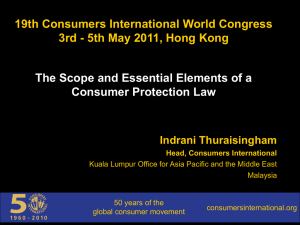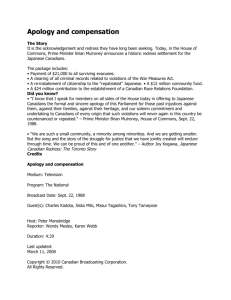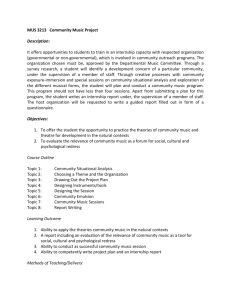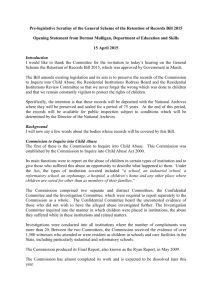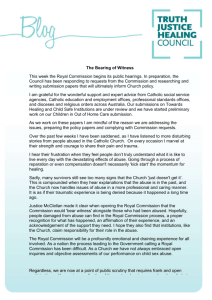A Victorian redress scheme for institutional child abuse
advertisement
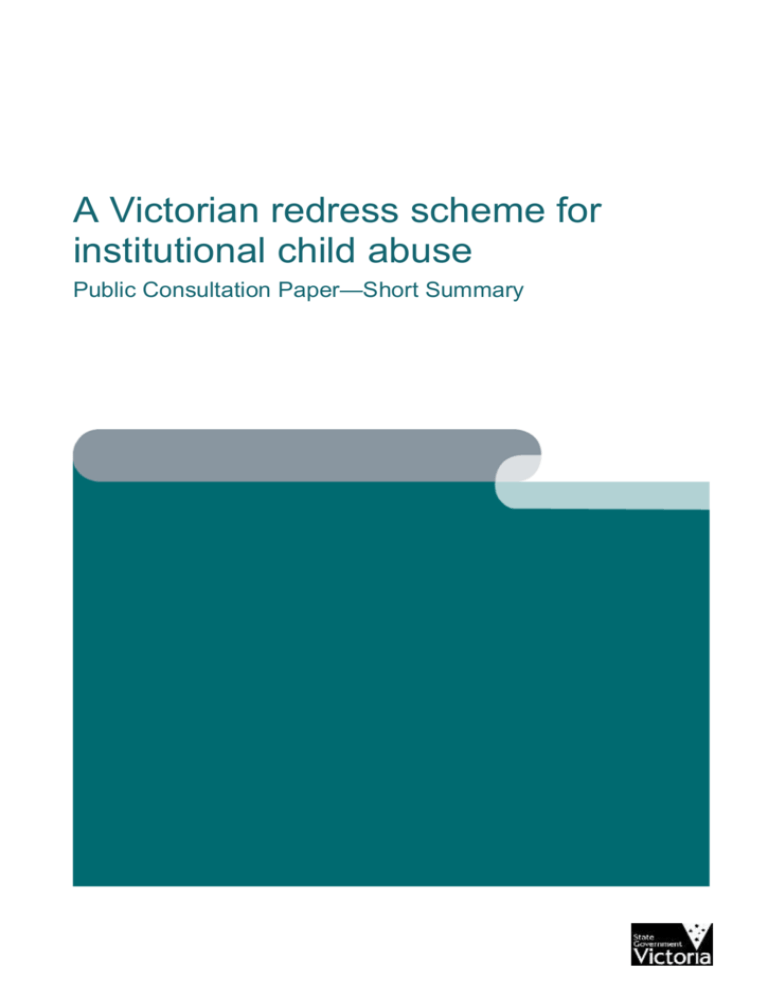
A Victorian redress scheme for institutional child abuse Public Consultation Paper—Short Summary Public Consultation Paper 1 Introduction 1.1 Public consultation A Victorian redress scheme for institutional child abuse The Victorian Government is giving members of the public an opportunity to have their say on a potential redress scheme for survivors of institutional child abuse in Victoria. To do this, the Government has released a public consultation paper that asks for input on a large range of issues relating to redress. That consultation paper is available at www.justice.vic.gov.au/redress. This document is a summary of the full paper. 1.2 The Betrayal of Trust report The Parliamentary Inquiry into the Handling of Child Abuse by Religious and Other Non-Government Organisations delivered the Betrayal of Trust report in November 2013.1 The Betrayal of Trust report recommended that the Government should consider creating another way for survivors of institutional child abuse to bring claims of abuse against institutions. Betrayal of Trust proposed what is commonly called a “redress scheme”. The Victorian Government has committed to implementing this recommendation. 1.3 What is a redress scheme? In the context of institutional child abuse, redress schemes are a way to address harms against an individual or group, and are an alternative to traditional avenues of justice, such as going to court. The Royal Commission into Institutional Responses to Child Sexual Abuse (the Royal Commission) has also been looking at the issue of redress. The Victorian Government has indicated that it supports the work of the Royal Commission, and is continuing to develop options for a potential Victorian redress scheme in response to Betrayal of Trust, while remaining open to participating in a national redress scheme or cooperating with other Australian governments, which are options that the Royal Commission may recommend. 2 The purpose of a Victorian redress scheme Redress schemes should have a statement of purpose, in order to help claimants, institutions and other participants understand the operation of a scheme and the benefits it offers. The Government proposes the following statement of purpose for a Victorian redress scheme: The purpose of the redress scheme is to recognise the harm caused by institutional child abuse. The scheme should support survivors to address the impacts of the abuse on their lives and obtain justice in a non-adversarial forum. It should provide a way for the institution to acknowledge the harm suffered by the survivor, and accept responsibility for its role in contributing to the abuse. 3 What organisations will be covered in a redress scheme? Betrayal of Trust and the Royal Commission look at institutional child abuse in a wide range of government and non-government organisations. Any redress scheme the Victorian Government establishes will cover both government and non-government institutions and organisations. One of the decisions to be made about a redress scheme is which organisations will participate in it. The Government suggests three options for resolving this decision: 1 Voluntary participation for any organisation. It is more likely that meaningful, good-faith redress will be provided by an institution when it makes a genuine, voluntary commitment to make amends to survivors of past abuse. However, not all organisations may decide to participate. Mandatory participation for all organisations. Any institution faced with a relevant claim of institutional child abuse would be required to participate in the scheme upon a claimant lodging an application. This would hold all relevant institutions to account for the past abuse of children. Mandatory participation for selected organisations. This option would compel selected institutions to participate in the redress scheme, and may ensure that the scheme is focused where appropriate. The full text of the Betrayal of Trust report is available at http://www.parliament.vic.gov.au/fcdc/article/1788 5 August 2015 Page 2 of 5 Public Consultation Paper 4 A Victorian redress scheme for institutional child abuse What forms of abuse will be covered by the scheme? It is clear from both Betrayal of Trust and the Royal Commission that children in institutions have been subjected to a range of harms that extend beyond sexual abuse.2 A redress scheme could potentially cover forms of institutional child abuse such as sexual abuse, physical abuse, psychological abuse, cultural abuse, and neglect. Redress schemes established in other states have generally addressed a broader range of harms—the Queensland scheme addressed physical abuse, sexual abuse, and neglect; the Western Australian and Tasmanian schemes addressed physical, sexual, psychological abuse and neglect; whilst the South Australian scheme is limited to sexual abuse only. 5 Assisting people other than survivors of abuse Betrayal of Trust and the Royal Commission have shown that the harm resulting from institutional child abuse can be felt beyond the person who originally experienced the abuse. A scheme could provide support to people related to or dependent on the person who experienced the abuse. One thing to consider, however, is that because of some organisations’ limited resources, a scheme that includes more people may have to provide less support to everyone. 6 How a redress scheme will process claims It is important for a redress scheme to contain a clear, consistent, and understandable process through which claims of redress are processed. 6.1 The application process The redress process normally begins with a written application. The Government’s preliminary view is that the application process should be as simple as possible, requiring only initial contact details and basic information from the person seeking redress. The scheme should then contact the claimant at a later date to determine the goals and outcomes he or she seeks, the support needs of the claimant, and the likely evidence available to support the claim. 6.2 Written or oral evidence Evidence may be gathered and verified in two main ways: in writing, or by speaking to people who make decisions about redress in-person or over the phone. A written process might require a written account of the abuse, accompanied by supporting documents and other material such as medical records, reports, personnel records and institutional correspondence. The scheme might then request further documentation if required. It may be that the person seeking redress does not need to supply all of these documents, and the redress scheme could ask the organisation for its records directly. As an alternative, information may be received and gathered over the phone, or through face-to-face interviews, hearings, or informal discussions. A written process may be suitable for less complex claims that do not require substantial investigation. Some survivors may prefer the approach of a written application, rather than having to tell their story. On the other hand, some survivors may wish to make their claims in-person or over the phone. The Royal Commission has indicated that some survivor groups have asked for hearings in a redress scheme, in order to allow survivors to tell their story. Ultimately, the Victorian Government wants to make sure that survivors are as comfortable and supported as possible throughout the process of redress. The Royal Commission currently favours a written process, noting that hearings lead to delays and extra administrative costs, and “should not be needed for applications to be fairly and properly assessed”.3 Betrayal of Trust’s recommendations were made in respect of the “criminal abuse of children”, which included unlawful physical assaults, sexual abuse offences, acts of criminal neglect, and the facilitation of such offences: Betrayal of Trust, page 29-30. 3 Royal Commission redress and civil litigation consultation paper, page 168-169. 2 5 August 2015 Page 3 of 5 Public Consultation Paper 7 A Victorian redress scheme for institutional child abuse The non-financial benefits offered by a redress scheme Institutional child abuse has many harmful effects on survivors’ physical, psychological, social, and economic well-being. In addition to a financial payment given to survivors, some past redress schemes have provided support services to help reduce the likelihood of any further trauma. The Royal Commission has identified counselling as the common shared non-financial need of all survivors of institutional child abuse.4 The Royal Commission has suggested that: counselling should be available on a life-long basis; counselling should be available on an episodic basis if required; 5 survivors should be able to choose between counselling options provided by appropriately capable professionals (who have the right capabilities to work with complex trauma clients); 6 subject to regular review, there should be no fixed limit on the number of counselling sessions available to a survivor; and family members should receive counselling through Medicare, and not through redress. 7 A scheme could also offer benefits other than counselling. It is important to note that the amount of non-financial benefits provided by a redress scheme may affect the amount of financial payments available under the scheme. 8 Providing an apology For many survivors, an apology provides a sense of validation that they have been listened to, believed and respected, and indicates that institutions have taken some kind of responsibility for past wrongs. The Royal Commission has suggested that all survivors should receive: an apology by the institution; an opportunity for the survivor to meet with a senior representative of the institution to allow the survivor to give an account of their experiences and to receive acknowledgement; and an assurance that the institution will take steps to prevent similar abuse in the future.8 An apology may be in an oral or written form, and may be addressed to individual survivors, their families, or whole communities. The Royal Commission has indicated that apologies should be carefully made so as not to reinforce any power imbalance between institution and survivor—in particular, institutions should not “dictate the agenda” for making apologies.9 It may be appropriate that standards are set by the redress scheme in this area, ensuring, for example, that face-to-face meetings are held in an appropriate and non-traumatic environment, perhaps with the involvement of an independent facilitator (if requested by the survivor) to manage the discussion and follow up on any agreed outcomes with the institution. 4 Royal Commission redress and civil litigation consultation paper, page 107-110. While there is a need for counselling that is accessible throughout a survivor’s life, it is not necessarily needed continuously. The episodic nature of many harms needs means that needs cannot be predicted accurately for individual survivors. 6 Some survivors may prefer support groups convened by broader support services, while other survivors may prefer private referrals. Some survivors do not want to use counselling services associated with the institutions in which they were abused, while other survivors prefer such services. 7 Royal Commission redress and civil litigation consultation paper, chapter 5. 8 Royal Commission redress and civil litigation consultation paper, page 82 9 Royal Commission redress and civil litigation consultation paper, page 83. 5 5 August 2015 Page 4 of 5 Public Consultation Paper 9 Call for submissions 9.1 Instructions A Victorian redress scheme for institutional child abuse This short summary paper summarises the main parts of the full redress consultation paper that was released by the Victorian Government on 5 August 2015. The full version of this paper is available on the Department of Justice & Regulation website at www.justice.vic.gov.au/redress. The Government invites stakeholders and members of the public to make a submission on a potential Victorian redress scheme for institutional child abuse by 5 October 2015. 9.2 How to make a submission Submissions may be provided in two ways. You may email your submission to redress@justice.vic.gov.au. Any attachments to your email should be provided in Microsoft Word format (.doc or .docx), or in Rich Text Format (.rtf). Please ensure that the file size of any attachments is less than 5MB. Alternatively, you may post your submission to: Redress Consultation Paper C/- Department of Justice & Regulation GPO Box 4356 Melbourne VIC 3000 Submissions may be made public unless otherwise requested. If you require assistance making a submission, please call the Victims Support Helpline between the hours of 8am and 11pm at 1800 819 817 (free call). The Government thanks you for your assistance in this important matter. 5 August 2015 Page 5 of 5

